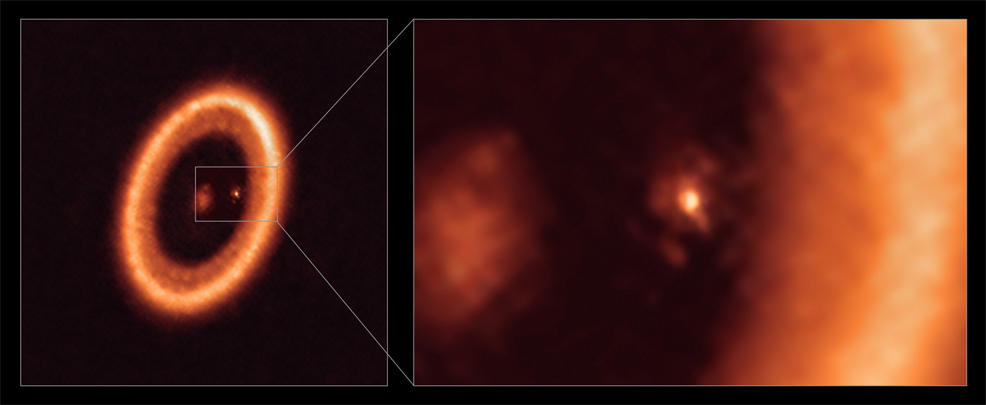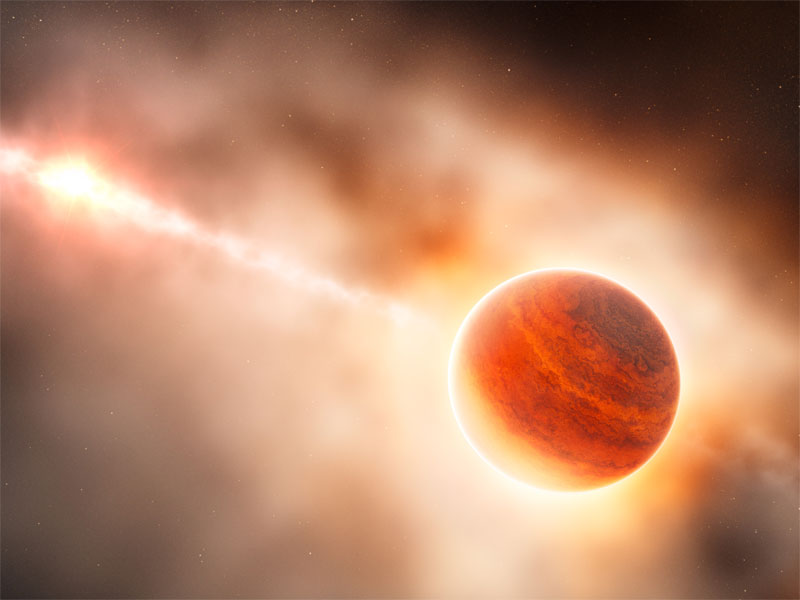
22nd July 2021 First clear detection of moon-forming disc around exoplanet Astronomers using the Atacama Large Millimetre/submillimeter Array (ALMA) have today reported the first clear detection of a moon-forming disc around an exoplanet.
According to their calculations, the disc has enough mass to form up to three satellites the size of our Moon. The observations are expected to shed new light on how moons and planets form in young stellar systems. "Our work presents a clear detection of a disc in which satellites could be forming," said Myriam Benisty, a researcher at the University of Grenoble, France, and the University of Chile, who led a new study published in The Astrophysical Journal Letters. "Our ALMA observations were obtained at such exquisite resolution that we could clearly identify that the disc is associated with the planet, and we are able to constrain its size for the first time." The disc in question – more accurately known as a circumplanetary disc – surrounds the exoplanet PDS 70c. This is one of two Jupiter-like planets orbiting a star called PDS 70. At only 5.4 million years old, it is a baby in astronomical terms, and of the variable class known as T Tauri. These represent an intermediate stage between a protostar and main sequence star. PDS 70 has a mass about 76% that of our Sun and the system is located 370 light years from Earth.
Planets form in dusty discs around young stars, carving out cavities as they gobble up material from this circumstellar disc to grow. In this process, a planet can acquire its own circumplanetary disc, which contributes to the growth of the planet by regulating the amount of material falling onto it. At the same time, gas and dust in the circumplanetary disc can come together into progressively larger bodies via multiple collisions, ultimately leading to the birth of moons. However, astronomers do not yet fully understand the details of these processes. "In short, it is still unclear when, where, and how planets and moons form," explains ESO Research Fellow Stefano Facchini, also involved in the research. "This system therefore offers us a unique opportunity to observe and study the processes of planet and satellite formation." "More than 4,000 exoplanets have been found so far, but all of them were detected in mature systems. PDS 70b and PDS 70c – which form a system reminiscent of the Jupiter-Saturn pair – are the only two exoplanets detected so far that are still in the process of being formed," explains Miriam Keppler, researcher from the Max Planck Institute for Astronomy in Germany and one of the co-authors of the study. Astronomers first discovered PDS 70b and PDS 70c using ESO's Very Large Telescope (VLT) in 2018 and 2019, respectively. Their unique nature means they have been observed with other telescopes and instruments many times since. The latest ALMA observations are so high resolution that it has now enabled researchers to gain further insights into the system. In addition to confirming the detection of the circumplanetary disc around PDS 70c and studying both its size and mass, they found that its neighbour, PDS 70b, does not show clear evidence of such a disc – suggesting that it was starved of dust material from its birth environment by PDS 70c. An even deeper understanding of the planetary system will be achieved with ESO's Extremely Large Telescope (ELT), currently under construction in the Chilean Atacama desert and scheduled to begin operations in 2025. "The ELT will be key for this research since, with its much higher resolution, we will be able to map the system in great detail," says co-author Richard Teague, researcher at the Smithsonian Astrophysical Observatory, USA. In particular, by using the ELT's Mid-infrared ELT Imager and Spectrograph (METIS), the team will be able to look at the gas motions surrounding PDS 70c to get a full 3D picture of the system.
Comments »
If you enjoyed this article, please consider sharing it:
|








